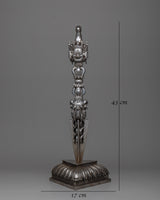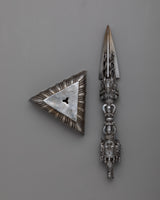









Tibetan Kila Phurba Dagger | Sacred Implement for Spiritual Transformation and Protection

100% AUTHENTIC

HANDMADE

FREE SHIPPING
Tibetan Kila Phurba Dagger
About Our Ritual Dragger
With our painstakingly wrought iron Tibetan Kila Phurba Dagger, set off on a spiritual exploration voyage. With its elaborate carvings and symbolic meaning, this ceremonial dagger—highly esteemed in Tibetan Buddhism—invites you to explore the limits of spiritual protection and wisdom. With its impressive dimensions of 43 cm in height and 17 cm in breadth, the dagger's intricate craftsmanship makes it a remarkable focal point for any altar or sacred area.
Every component of the phurba has been meticulously designed to uphold custom and inspire reverence. Every element, including the pointed blade and the exquisitely carved handle, represents the transformational force of compassion and knowledge. This phurba, which is supported by an iron stand, is a powerful representation of the search of enlightenment and spiritual perseverance. Its weight of 3.382 kg gives it a tangible presence that encourages people to be mindful and reflect. Set out on a journey of spiritual awareness and protection by feeling the profound energy of the Tibetan Kila Phurba Dagger.
Introduction To The Buddhist Ritual Dragger :
Ritual tools are vital equipment of Tibetan Vajrayana Buddhism practice, meant to dispel misconceptions obstructing enlightenment. The phurba (Sanskrit: Kila) blade seen here was created to symbolically swallow the three poisons that obstruct spiritual progress: ignorance, greed, and illusion. The Phurba is the physical manifestation of the Vajrakila Buddha, who has the ability to destroy all evil on the earth. Its ceremonial usage is first recorded in the Vajrakilaya Tantra, an eighth-century or older Vajrayana work.
--------------------------------------------
Size: 43 cm (Height) x 17 cm (Width)
Weight: 3.382 kg
Material: Iron
--------------------------------------------
How to set up your own Buddhist Shrine?
Find a clean, quiet, and uncluttered spot
Set up an altar table, and cover it with an altar cloth that calls to you
Place your sacred item (statue, thangka, or a picture of Buddha) at the centre




















